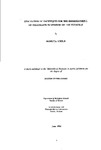Evaluation of Techniques For The Biomonitoring of Pollutants in Members of The Ulvaceae
| dc.contributor.author | Schild, Rebecca | |
| dc.contributor.other | School of Biological and Marine Sciences | en_US |
| dc.date.accessioned | 2013-11-07T13:34:35Z | |
| dc.date.available | 2013-11-07T13:34:35Z | |
| dc.date.issued | 1996 | |
| dc.identifier | NOT AVAILABLE | en_US |
| dc.identifier.uri | http://hdl.handle.net/10026.1/2667 | |
| dc.description | Merged with duplicate record 10026.1/1279 on 14.03.2017 by CS (TIS) | |
| dc.description.abstract |
This study involved the development and evaluation of a number of biomonitoring techniques for use with members of the Ulvaceae, Enteromorpha intestinalis (L.) Link, and Viva lactuca (L.). The techniques included both previously established ones and those which required development. The two main procedures developed for these algae were the neutral red retention technique (making use of a vital stain) and the ion leakage Health Index (based upon electrolyte leakage). Following optimisation both were used to produce quantitative structure-activity relationships (QSARs) for a series of n-alcohols using log KOW as the physicochemical parameter. The resultant QSARs were statistically indistinguishable with line equations of -0.88 log KOW + 2.87 and -0.95 log KOW + 2.83 respectively, with r² values of 0.98, suggesting that both reflect the same non-specific narcotic effect on membrane integrity. However the neutral red retention technique was less useful than the Health Index with low reproducibility and is therefore unsuitable for use as an environmental biomonitor. The effects of other compounds with specific modes of action were established using the ion leakage technique, the high toxicity of the antifouling compound tributyltin being reflected in the Health Index. Further development of the ion leakage technique involved inductively coupled - plasma mass spectrometry (ICP/MS) in the identification of ions lost during leakage. Synergistic toxicity was investigated exposing the algae to UV light and anthracene, simulating photo-induced toxicity. No photo-induced toxicity was observed although UV exposure did reduce the Health Index. An environmental assessment was carried out for algae from clean sites and organically and inorganically polluted sites, comparing the Health Index with other measures of health and bioaccumulation data. A long term study of a clean site showed the algal Health Index to be influenced by seasonally dependent physical parameters, but reflected reduced health in algae exposed environmentally to organic pollutants. Algae exposed to long term heavy metal pollution in the Fal Estuary had 'normal'. Health Indices, however chlorophyll fluorescence induction techniques did highlight a reduced photosynthetic efficiency in these algae. The ion leakage technique has potentially a wide application in field and laboratory based biomonitoring and direct toxicity studies. Chlorophyll fluorescence analysis was also shown to be useful although it requires further investigation and evaluation. | en_US |
| dc.description.sponsorship | Plymouth Marine Laboratories and Zeneca, Brixham | en_US |
| dc.language.iso | en | en_US |
| dc.publisher | University of Plymouth | en_US |
| dc.title | Evaluation of Techniques For The Biomonitoring of Pollutants in Members of The Ulvaceae | en_US |
| dc.type | Thesis | |
| plymouth.version | Full version | en_US |
| dc.identifier.doi | http://dx.doi.org/10.24382/1551 | |
| dc.identifier.doi | http://dx.doi.org/10.24382/1551 |
Files in this item
This item appears in the following Collection(s)
-
01 Research Theses Main Collection
Research Theses Main


